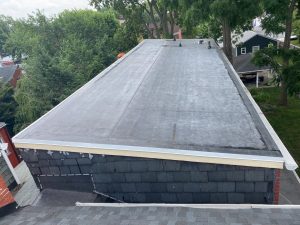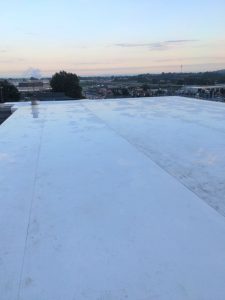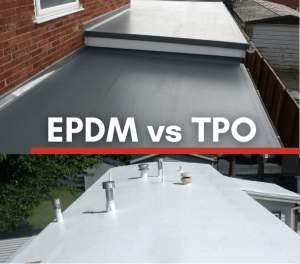When going to replace your flat roof, you often choose the same material that was on it. However, you should consider alternatives based on longevity, cost, and the local climate.
While shingles come in multiple colors and styles, low-sloped roofs don’t have as many options. Single-ply membranes such as TPO and EPDM are very commonly used materials for flat or low-sloped roof systems.
What is EPDM?
EPDM stands for Ethylene Propylene Diene Monomer. EPDM is black. This is a soft but durable synthetic rubber roofing membrane that has been a favorite of roofing design professionals for 40+ years.
It often lasts 20-30 years depending on the thickness of the material. Its elasticity allows it to expand with fluctuating weather conditions. The actual membrane itself can often last 30-40 years, but the details such as seams, penetration flashing, wall terminations, etc… usually limit the lifetime of the system.

EPDM’s Heating Advantage
The advantage of this product on a roof increases the farther North you are. This is because Northern climates have colder temperatures, and it costs more to heat the building during cold months than it does to cool it in warmer months. With a black roof, the building can absorb more of the sun’s warmth, keeping heating costs lower.
EPDM, just like any flat roof material, is subject to punctures from sharp objects. EPDM is an easily reparable material. So in the case that a puncture or tear does occur, it can be repaired quite easily with the correct materials.
What is TPO?
Thermoplastic Polyolefin, or TPO, came into the commercial low-slope and flat roof market in the early 1990’s. It was a very popular alternative to black EPDM, bringing the benefits of easier and faster installation methods to the industry. Because it is embedded with strong fibers, this material can be mechanically fastened to the roof system, instead of glued as is necessary for EPDM. TPO has been a popular, reliable roof system for the last 20-30 years.

TPO’s Energy Efficiency
As a white membrane, it reflects much of the sun’s energy, making it a very good material to be used in areas where the cooling costs are higher than heating costs. It’s resistant to fire, mold growth, and UV rays have made it a widely used industry standard.
Furthermore, TPO systems don’t rely on tapes and other sealants at seams. Rather, seams are heat-welded together to form a strong, long-lasting, watertight bond between sheets, making it a truly superior low-slope membrane system. TPO’s seam strength is considered to be about 3-4 times stronger than EPDM.
What is the cost difference?
On a smaller scale, EPDM usually has cheaper installation costs. However, on larger projects, time-savings in the TPO roof system usually eclipse it’s slightly more expensive material costs, making TPO the better option.
TPO tends to need less maintenance during it’s lifespan than EPDM. This is due to the fact that EPDM requires special tapes and sealers at all seams and penetrations, whereas TPO relies on heat-welded seams.
Either system can be patched and repaired quite easily in the case of punctures or damage.
Does climate matter?
Since EPDM is a black material, it absorbs more heat than TPO. Because of this, roofs in hotter climates may benefit from choosing TPO since the white color can help reflect the sun’s rays. They can be considered the cooling technology of flat roofing systems.
This can become especially important for commercial buildings. On a distribution center roof that we replaced in August 2021 in Lancaster, PA, we performed a temperature test. The ambient temperature was 90 degrees Fahrenheit. The EPDM registered 168 degrees while the TPO measured 118 degrees!
The black material could benefit homes that experience a fair amount of winter weather. The roof could serve as a heating element to the building and helps melt ice and snow faster.
Which is best for my roof?
In the Mid-Atlantic region, the residential market still favors the black EPDM system. EPDM is easy to install, and on small roofs is usually the cheaper option. Here in Pennsylvania, heating and cooling costs can be similar, as we don’t have extremes of cold or warmth.
In commercial applications, TPO is the clear winner. The combination of reflectivity, resistance to punctures, tensile strength, and heat-welded seams makes it a highly favorable roofing material.
Both systems can be matched with various types of substrates such as plywood or fiberboard, or Poly-ISO substrate to gain high levels of insulation value in the roof.
Discuss Your Flat Roofing Needs with Joyland Roofing
Discussing with a roofer what’s best for your low-sloped roof can be frustrating. Joyland Roofing wants to make sure you never feel out of the loop. We want to inspect your roof and provide you with a straightforward estimate that meets your roofs needs.
Whether a commercial flat roof or a residential flat roof, Joyland Roofing would love to discuss the project with you.
Pennsylvania Home Improvement Contractor License (HIC) # PA124258



